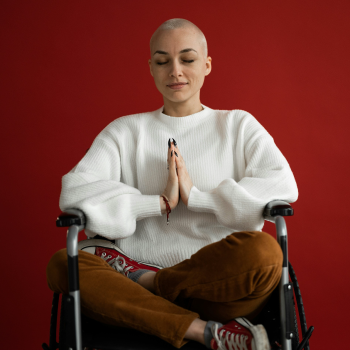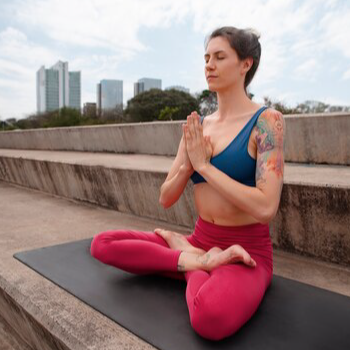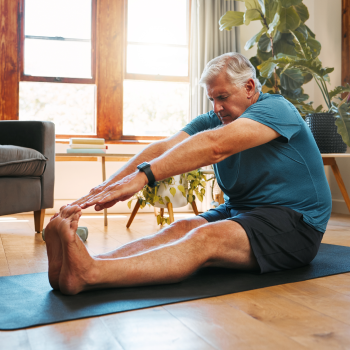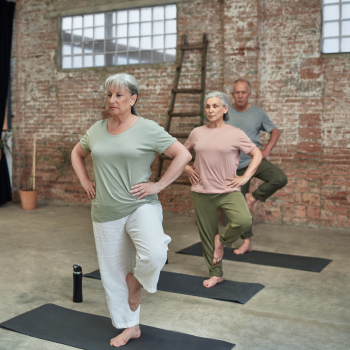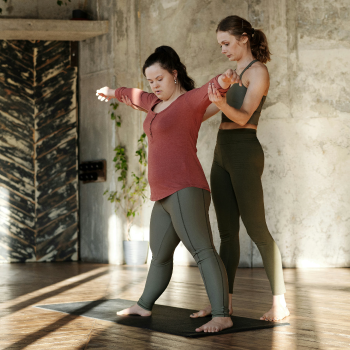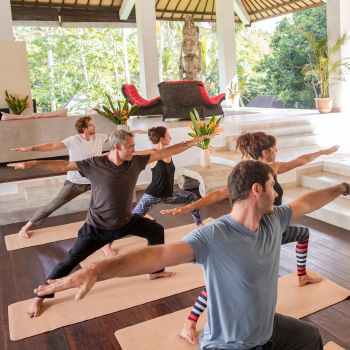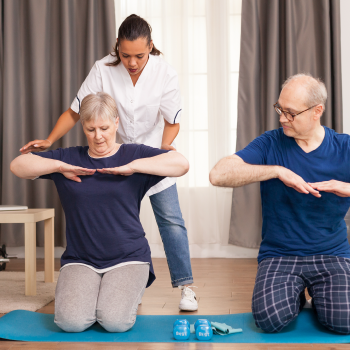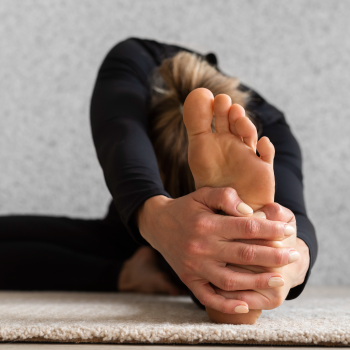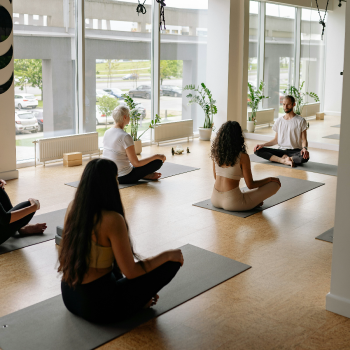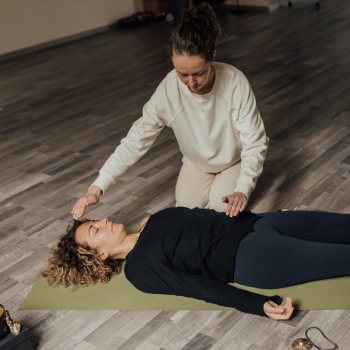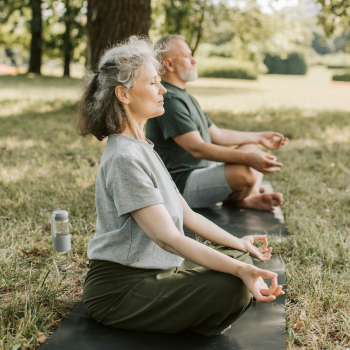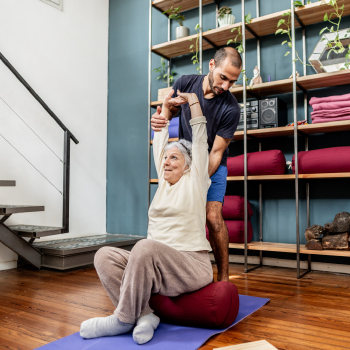In a pioneering pilot study on yoga-integrated psychotherapy, participants showcased marked betterment in emotion regulation, diminished stress, and heightened overall well-being. This innovative fusion of traditional yoga practices—including mindful movement, breathwork, and meditation—with evidence-backed psychotherapy techniques presents a compelling treatment pathway for those grappling with emotion dysregulation.
Yoga-Integrated Psychotherapy (YiP): A Case Study on Emotion Regulation
Introduction:
Emotion dysregulation can manifest in various ways, from mood swings and impulsive behavior to difficulties in interpersonal relationships. In this backdrop, the intersection of traditional practices like yoga and modern psychotherapy offers intriguing possibilities for treatment.
Background:
Yoga, a mind-body practice with roots in ancient India, aims to unify the body and mind through a series of postures, breathing exercises, and meditation. Over the years, yoga has gained recognition for its potential physical and mental health benefits, from managing chronic pain to reducing symptoms of depression.
The Case:
Subject: A 35-year-old female presented with a history of recurrent depressive episodes, anxiety, and difficulty in regulating emotions.
Initial Assessment: Upon initial assessment using the Difficulties in Emotion Dysregulation Scale (DERS), the subject scored significantly, indicating pronounced emotion regulation challenges.
Intervention:
Yoga-integrated Psychotherapy (YiP): Based on the promising intersections of yoga and psychotherapy, a tailored YiP intervention was designed. The program involved:
One psychological assessment session.
Six weekly one-hour therapy sessions integrating yoga postures, breathing techniques, and psychotherapeutic discussions.
Outcomes:
Quantitative Analysis: Post-intervention DERS scores indicated significant improvement in emotion regulation. Moreover, self-report measures pointed towards heightened well-being and reduced depressive and anxious symptoms.
Qualitative Analysis: In follow-up interviews, the subject highlighted:
Enhanced emotional and psychological processing.
Improved self-insight and focus.
Appreciation for the cultural sensitivity of the approach.
A newfound realization of how the body can be a powerful tool for resilience and regulation.
Overall acceptance and positive impact of the integrated therapy.
Discussion:
The positive outcomes from this case study emphasize the potential benefits of integrating yoga into psychotherapy.
Specifically:
Holistic Approach: Addressing both mind and body simultaneously might offer more comprehensive treatment outcomes.
Cultural Sensitivity: For those who resonate with the cultural origins of yoga, such an approach may feel more personalized and less alienating than some Western psychotherapies.
Economic Viability: If effective, such integrative treatments could be cost-effective, offering patients techniques they can continue at home.
Versatility: The adaptability of yoga means that it can potentially be tailored to suit individual needs, making it a versatile tool in therapeutic settings.
Recommendations for Practice and Policy:
Explore the integration of yoga into therapy modalities beyond just CBT, given its potential benefits.
Adopt a trauma-sensitive approach, especially when dealing with individuals with pronounced emotion dysregulation.
Policy-making bodies like NICE might consider expanding guidelines to include yoga-based interventions for mental health issues.
Conclusion:
This case study provides a compelling narrative on the potential of integrating ancient practices like yoga into modern psychotherapeutic techniques. The tangible benefits observed suggest that a mind-body approach could be a valuable tool in addressing emotion dysregulation and related mental health challenges. Future studies with larger sample sizes are needed to validate and generalize these findings.
Summary:
1.2 Emotion Dysregulation
Emotion dysregulation is not just a specific symptom but multi-dimensional, encompassing various mental health issues.
It often appears in individuals who have faced complex trauma or interpersonal problems.
Emotion dysregulation is characterized by intense and uncontrollable emotions.
1.3 The Current Study
The study aimed to evaluate the merger of yoga with psychotherapy and its impact on emotion dysregulation and well-being.
It used quantitative self-report measures and qualitative interviews.
They also intended to inform the development of a Yoga-integrated Psychotherapy (YiP) model.
2. Methods
The study was ethically approved by the University of Roehampton's research ethics committee.
Sessions took place at the CREST Therapy and Research Clinic.
Consent was obtained from all participants.
Participants had the right to withdraw from the study.
2.1 Participants
Seven students participated, recruited through printed advertisements.
The criteria for selection were individuals believing in the benefits of psychological intervention and a score above 62.5 on the Difficulties in Emotion Dysregulation Scale (DERS).
Individuals with serious mental health issues, certain physical illnesses, or known to the therapist were excluded.
2.2 Procedure
The therapy, called Yoga-integrated Psychotherapy (YiP), combined yoga and psychotherapy.
Sessions were split: 30 minutes of yoga followed by 30 minutes of talking therapy.
The therapist adapted the yoga poses to individual needs.
Participants completed seven sessions, including an initial psychological assessment session.
The therapy integrated elements of psychodynamic practice with techniques from other therapies.
2.3 Self-report Measures
Measures included the Difficulties in Emotion Regulation Scale (DERS), the Patient Health Questionnaire (PHQ-9), the Generalized Anxiety Disorder scale (GAD-7), the Warwick–Edinburgh Mental Well-being Scale (WEMWBS), and a session effectiveness scale (SES).
2.4 Physiological Measures
Participants wore a heart rate variability (HRV) monitor during sessions.
Due to the COVID-19 pandemic and subsequent online sessions, data from HRV was missing for some participants.
2.5 Qualitative Interviews
After the therapy, participants were interviewed.
Interviews lasted 40-60 minutes.
Thematic analysis was applied to the data.
2.6 Quantitative Analyses
The effects of YiP on various measures were evaluated.
Data from all sessions was analyzed to understand any significant differences between sessions.
This study examines the effects of a therapy approach integrating yoga with psychotherapy, known as Yoga-integrated Psychotherapy (YiP). The results are presented in various sections that assess the impact of the therapy on different psychological measures.
3.1 Participant Characteristics:
The study enrolled seven participants (5 females, 2 males).
One participant dropped out after the first session. Thus, six participants (4 females, 2 males) completed the study.
3.2 Difficulties in Emotion Regulation Scale (DERS):
Overall, participants showed a reduction in difficulties in emotion regulation after undergoing YiP.
Total DERS scores decreased significantly over the course of the sessions.
Significant improvements were also seen in the subscales of lack of emotional clarity, difficulty in engaging goal-directed behavior, nonacceptance of emotional responses, and limited access to emotion regulation strategies.
Age and gender did not influence the scores.
3.3 Warwick–Edinburgh Mental Well-being Scale (WEMWBS):
There was a significant increase in mental well-being scores over the course of the sessions.
Specific items from the scale, such as "feeling useful" and "thinking clearly," also showed significant improvements.
Age and gender did not impact these scores.
3.4 Generalized Anxiety Disorder (GAD-7) Questionnaire:
Overall, there was no significant change in GAD-7 total scores.
However, specific items like "Becoming easily annoyed or irritable" and "Being so restless that it's hard to sit still" showed significant improvements.
Age and gender did not influence these results.
3.5 Session Evaluation Scale:
No significant difference was observed in the client-scored evaluations of sessions.
There was a significant difference in how therapists evaluated the sessions, with improvements noted in some specific items.
3.5.1 Qualitative Analysis:
The research team conducted interviews to gather qualitative data about the participants' experiences.
Five main themes were identified:
YiP Assists Clients' Psychological and Emotional Processing: Participants found the combination of yoga and therapy helpful. They felt that yoga prepared them for talking therapy by opening their minds and easing potential discomfort. It also helped them manage the emotional load.
YiP Improves Insight and Focus: Participants reported improved focus during sessions, allowing them to choose specific topics to discuss. They also felt that yoga helped bring about insights that they could later explore in the talking portion of the session.
The rest of the themes are not presented in the provided text.
The figures show visual representations of the results. For example, Figure 1 depicts the DERS scores over the course of the therapy sessions, and Figure 2 represents the WEMWBS scores.
In summary, the results suggest that the integration of yoga with psychotherapy (YiP) may have positive effects on emotion regulation, mental well-being, and certain aspects of anxiety. The qualitative data further supports these findings, with participants reporting benefits in emotional processing and increased focus and insight.
Integrating Yoga into Psychotherapy for Enhanced Emotion Regulation
Background: Modern therapeutic approaches often seek integrative models to address the comprehensive needs of clients. One such integrative model combines yoga with traditional psychotherapy, termed as Yoga in Psychotherapy (YiP). This case study examines the experiences and outcomes of participants who undertook a YiP intervention.
Methodology: The study was derived from an article downloaded from Wiley Online Library, where participants underwent a 6-week YiP intervention. Qualitative data were gathered from these participants to determine the perceived efficacy and impact of the approach.
Participant Experiences:
- Physical and Emotional Tension Release:
- Participants felt a noticeable difference in their bodily tension, especially towards the end of their yoga sessions.
- One participant expressed: “...knowing that in therapy we talk about very hard issues. And there is a tension in your body. That tension...especially in the last part, the relaxing part [of the yoga practice]...goes away.”
- Improved Emotion Regulation:
- All participants reported experiencing a positive shift in emotion regulation.
- They described feeling a renewed connection with their bodies, especially helpful for those presenting with trauma symptoms.
- Acceptability and Impact of YiP:
- The intervention was found to be favorable. As one participant noted, “there wasn't anything I would prefer to be done differently.”
- Some expressed a desire for more extended sessions to allow for more discussion after the yoga practice.
- Integration of Yoga and Talk Therapy:
- Participants appreciated the seamless integration of yoga and talk therapy.
- One stated: “It wasn't like, oh we are doing yoga now and then we will talk...it was laid back towards care and mood of the day. It was a nice experience.”
- Feasibility of Skills in Daily Life:
- Participants reported successfully practicing yoga outside of the intervention, signaling the transfer of skills to daily life.
Key Outcomes:
Reduction in Symptoms:
- Decrease in distress symptoms, with one participant noting a significant reduction in flashbacks.
- Enhanced Self-Agency:
- Participants recognized their power in facilitating change, rather than solely relying on the therapist.
- Life-Long Skills Development:
- Participants felt the intervention equipped them with skills they could apply for the rest of their lives.
- A participant highlighted: “The yoga [psycho]therapy has been life-changing, absolutely life-changing, cause I have learned skills I can apply literally for the rest of my life.”
Conclusion: The integration of yoga into psychotherapy offers a unique approach that appears to resonate positively with participants. The themes extracted from participants' experiences underline the potential benefits of such a model, from the release of tension to the acquisition of life-long emotional regulation skills. This case study showcases the potential of YiP as a viable therapeutic approach, deserving of further research and consideration.
Yoga-Integrated Psychotherapy (YiP): A Case Study on Emotion Dysregulation Management
Introduction
The integration of yoga and psychotherapy has recently surfaced as a novel approach to alleviate emotion dysregulation among university students. Known as Yoga-Integrated Psychotherapy (YiP), this method synthesizes two disciplines, offering an enhanced treatment framework. This case study aims to delve into the utility, acceptability, and effects of the YiP intervention.
Background
Emotion dysregulation, defined as the inability to manage and respond to an emotional experience effectively, has been identified in numerous individuals, leading to a spectrum of mental health issues. Given the increasing mental health concerns among university students, innovative interventions like YiP, which incorporate both mental and physical modalities, can be particularly beneficial.
Methodology
YiP sessions were carried out, blending hatha yoga postures with integrative psychotherapeutic practices. The primary focus was on improving emotional well-being, reducing irritability, and managing symptoms of emotion dysregulation.
Results
1. Acceptability & Feasibility:
Helpful Aspects: The yoga component of YiP helped with relaxation, positive mental focus, and offered a holistic approach by involving the body in the recovery process.
Unhelpful Aspects: Not explicitly mentioned, but one participant dropped out after one session due to academic demands.
Cultural Sensitivity: YiP was found to be culturally adaptable and did not clash with religious beliefs, largely due to the therapist’s empathetic and culturally sensitive approach.
2. Impact on Emotion Dysregulation & Well-being:
A marked decrease in emotion dysregulation symptoms such as flashbacks, anxiety, and irritability was noted.
Participants showcased increased resilience and an improved ability to manage stress.
3. Integration Benefits:
Yoga practice enhanced session engagement, allowing participants to address deeper psychological issues more readily.
Limitations
The study had a small sample size, with just seven participants, limiting the generalizability of the findings.
The COVID-19 pandemic led to the delivery of seven out of the 45 total sessions online, which could influence the intervention's effectiveness.
Conclusion
The preliminary findings of the YiP intervention are promising. By merging yoga with psychotherapy, this model offers a fresh approach to address emotion dysregulation. Future studies with larger sample sizes and diverse populations are essential to ascertain the wider applicability of this novel method.
Acknowledgements
Support from the University of Roehampton and invaluable guidance from esteemed professors and experts played a crucial role in this study. The authors declare no conflicts of interest, and all procedures adhered to the Declaration of Helsinki.
This case study illustrates the potential of the Yoga-Integrated Psychotherapy approach in alleviating symptoms of emotion dysregulation, especially among university students. Future research can explore its broader applications in varied populations.
https://drive.google.com/drive/folders/1rN3z8pK56qnS5Vnnv7ExD4sAPV-rY83-
Written By: Ram on 06-02-2023

